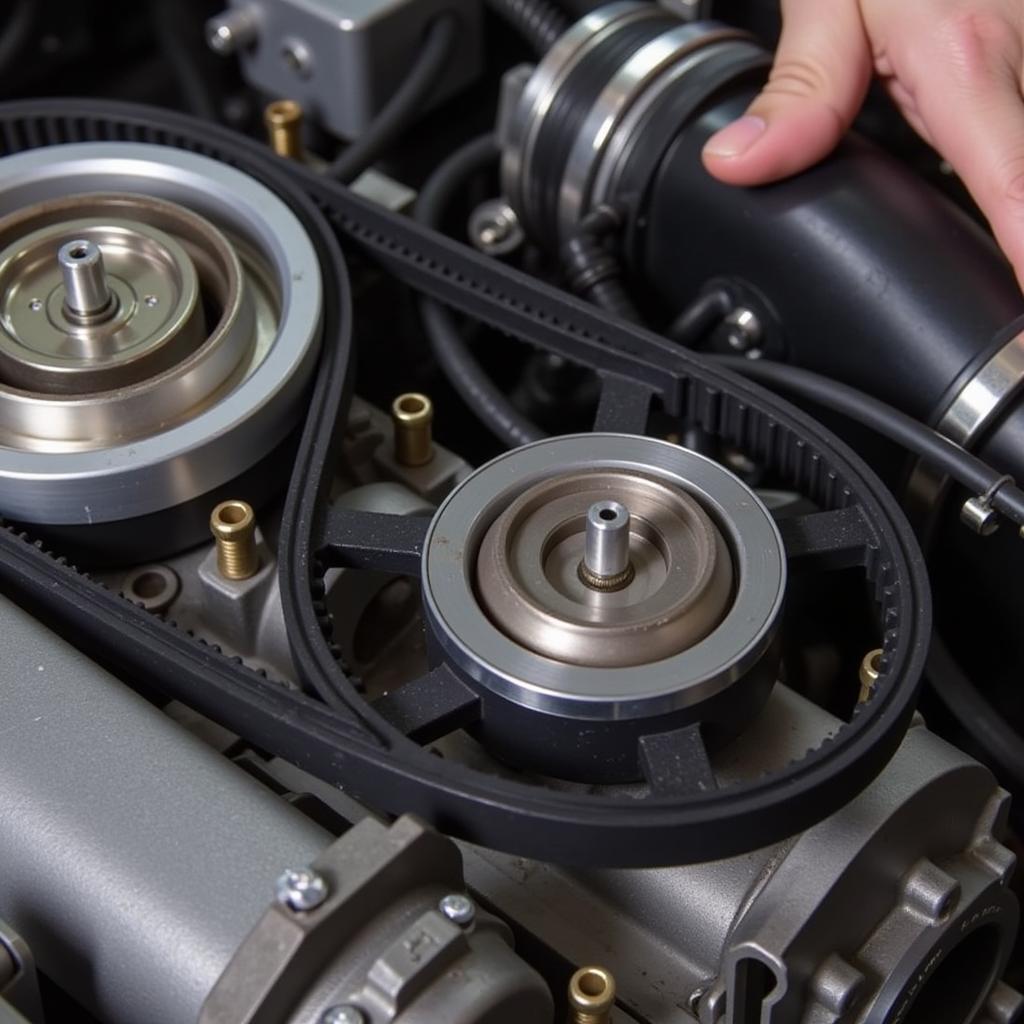A car that has jumped time can lead to significant engine problems, and understanding how to diagnose and fix this issue is crucial. Whether you’re a DIY mechanic or considering taking your car to a shop, this article will guide you through the process of fixing a car that jumped time. how to fix timing issue on car We’ll cover everything from identifying the symptoms to the necessary tools and steps involved.
What Does it Mean When a Car Jumps Time?
“Jumping time” refers to a situation where the engine’s timing belt or chain slips, causing the camshaft and crankshaft to become misaligned. This misalignment disrupts the precise synchronization required for proper engine function. The intake and exhaust valves open and close at the wrong times, leading to poor performance or even catastrophic engine damage.
Signs Your Car Might Have Jumped Time
Recognizing the signs of a jumped timing belt or chain is vital for preventing further damage. Common symptoms include:
- Engine misfires: A rough idle or stuttering during acceleration.
- Loss of power: The engine feels sluggish and unresponsive.
- Backfiring: Loud pops or bangs from the exhaust system.
- Check engine light: The engine warning light illuminates on the dashboard.
- Engine won’t start: In severe cases, the engine may not crank at all.
 Car Engine Misfiring due to Jumped Timing
Car Engine Misfiring due to Jumped Timing
How to Fix a Car That Jumped Time: A Step-by-Step Guide
Fixing a jumped timing belt or chain is a complex process. While a skilled DIYer can tackle it, it’s often best left to a professional mechanic. Here’s a general overview of the process:
- Gather the necessary tools: You’ll need a timing belt/chain kit, appropriate wrenches and sockets, and specialized tools like a crankshaft pulley holder and camshaft alignment tools.
- Remove the interference: Depending on the vehicle, you might need to remove components like the serpentine belt, water pump, and other parts obstructing access to the timing belt/chain cover.
- Access the timing belt/chain: Carefully remove the timing belt/chain cover.
- Align the timing marks: This is the most crucial step. Using the timing marks on the crankshaft and camshaft sprockets, align them according to the manufacturer’s specifications.
- Install the new timing belt/chain: Ensure proper tension and alignment before tightening everything down.
- Reassemble everything: Put all the removed components back in place.
- Verify the repair: Double-check all connections and start the engine to ensure it runs smoothly.
 Aligning Camshaft and Crankshaft Timing Marks
Aligning Camshaft and Crankshaft Timing Marks
“Getting the timing right is absolutely critical. Even a slight misalignment can lead to significant engine problems down the road,” advises John Miller, a seasoned automotive technician with over 20 years of experience.
How to Prevent a Timing Belt/Chain from Jumping
Regular maintenance is key to preventing a jumped timing belt or chain. Follow your vehicle’s recommended maintenance schedule for timing belt/chain replacement. Also, address any oil leaks promptly, as oil can degrade the belt/chain material.
how to fix timing issue on car
“Don’t underestimate the importance of preventive maintenance. Replacing the timing belt/chain at the recommended intervals is a small price to pay compared to the cost of a major engine repair,” adds Sarah Chen, a certified mechanic and automotive instructor.
 New Timing Belt Installation
New Timing Belt Installation
What to Do If You Suspect Your Car Has Jumped Time
If you suspect your car has jumped time, stop driving immediately and have it towed to a qualified mechanic. Continuing to drive could cause severe and irreversible engine damage.
Conclusion
Dealing with a car that has jumped time is a serious matter. Understanding the symptoms, causes, and repair process is essential. While a DIY approach is possible for experienced mechanics, seeking professional help is often the safest and most reliable option. Remember, regular maintenance is crucial for preventing this issue and ensuring the longevity of your engine. Don’t hesitate to contact AutoTipPro at +1 (641) 206-8880 or visit our office at 500 N St Mary’s St, San Antonio, TX 78205, United States if you need assistance with your vehicle’s timing issues.
FAQ
- Can a jumped timing belt be fixed without replacing it? No, a jumped timing belt needs to be replaced.
- How much does it cost to fix a car that jumped time? The cost varies depending on the vehicle and the extent of the damage.
- Can a jumped timing chain cause engine damage? Yes, a jumped timing chain can cause significant engine damage, including bent valves and damaged pistons.
- How often should a timing belt be replaced? Consult your vehicle’s owner’s manual for the recommended replacement interval.
- What is the difference between a timing belt and a timing chain? A timing belt is made of rubber and requires periodic replacement, while a timing chain is made of metal and typically lasts the lifetime of the engine.
- Can I drive my car if the timing belt has jumped? No, do not drive your car if the timing belt has jumped. Have it towed to a mechanic.
- How do I know if my car has an interference engine? Consult your vehicle’s owner’s manual or a reliable online source to determine if your engine is an interference type.




Leave a Reply